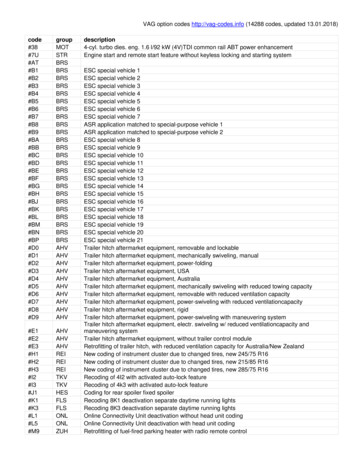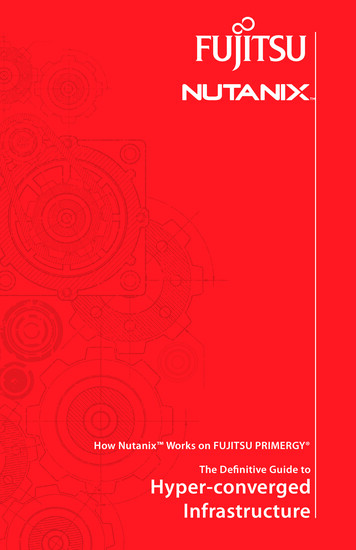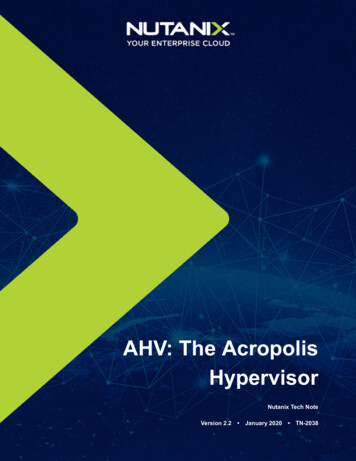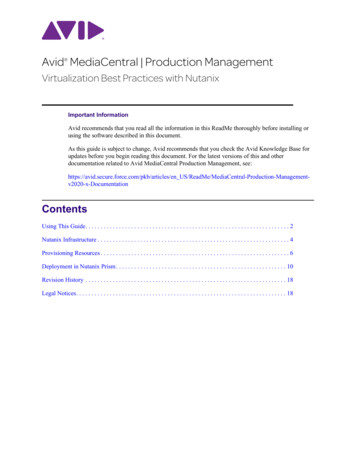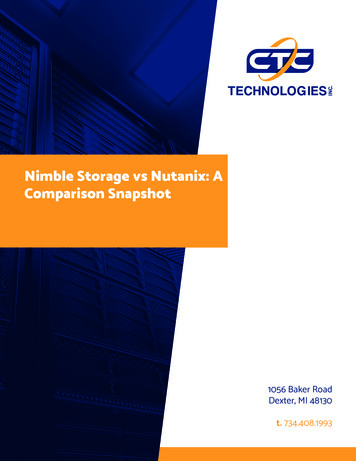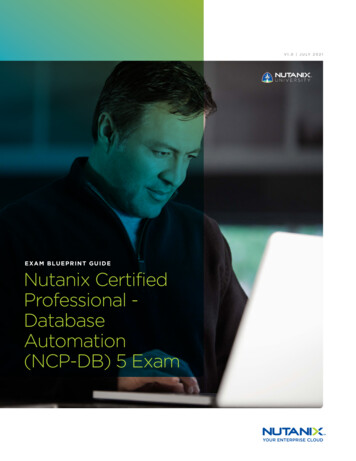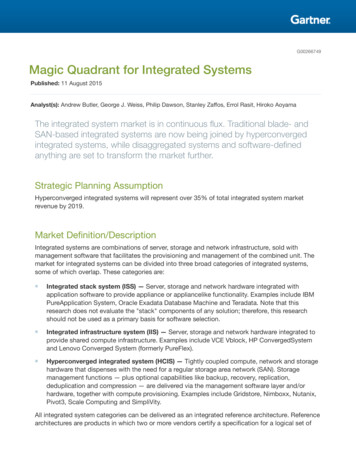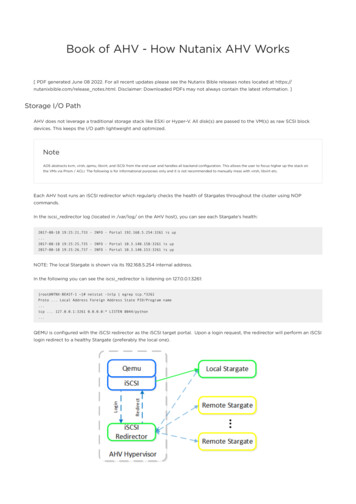
Transcription
Book of AHV - How Nutanix AHV Works[ PDF generated June 08 2022. For all recent updates please see the Nutanix Bible releases notes located at https://nutanixbible.com/release notes.html. Disclaimer: Downloaded PDFs may not always contain the latest information. ]Storage I/O PathAHV does not leverage a traditional storage stack like ESXi or Hyper-V. All disk(s) are passed to the VM(s) as raw SCSI blockdevices. This keeps the I/O path lightweight and optimized.NoteAOS abstracts kvm, virsh, qemu, libvirt, and iSCSI from the end-user and handles all backend configuration. This allows the user to focus higher up the stack onthe VMs via Prism / ACLI. The following is for informational purposes only and it is not recommended to manually mess with virsh, libvirt etc.Each AHV host runs an iSCSI redirector which regularly checks the health of Stargates throughout the cluster using NOPcommands.In the iscsi redirector log (located in /var/log/ on the AHV host), you can see each Stargate's health:2017-08-18 19:25:21,733 - INFO - Portal 192.168.5.254:3261 is up.2017-08-18 19:25:25,735 - INFO - Portal 10.3.140.158:3261 is up2017-08-18 19:25:26,737 - INFO - Portal 10.3.140.153:3261 is upNOTE: The local Stargate is shown via its 192.168.5.254 internal address.In the following you can see the iscsi redirector is listening on 127.0.0.1:3261:[root@NTNX-BEAST-1 ]# netstat -tnlp egrep tcp.*3261Proto . Local Address Foreign Address State PID/Program name.tcp . 127.0.0.1:3261 0.0.0.0:* LISTEN 8044/python.QEMU is configured with the iSCSI redirector as the iSCSI target portal. Upon a login request, the redirector will perform an iSCSIlogin redirect to a healthy Stargate (preferably the local one).
iSCSI Multi-pathing - Normal StateThe preferred controller type is virtio-scsi (default for SCSI devices). IDE devices, while possible, are not recommended for mostscenarios. In order for virtio to be used with Windows the virtio drivers, Nutanix mobility drivers, or Nutanix guest tools must beinstalled. Modern Linux distros ship with virtio pre-installed.In the event where the active Stargate goes down (thus failing to respond to the NOP OUT command), the iSCSI redirector willmark the local Stargate as unhealthy. When QEMU retries the iSCSI login, the redirector will redirect the login to another healthyStargate.iSCSI Multi-pathing - Local CVM DownOnce the local CVM's Stargate comes back up (and begins responding to the NOP OUT commands), the remote Stargate willquiesce then kill all connections to remote iSCSI sessions. QEMU will then attempt an iSCSI login again and will be redirected tothe local Stargate.iSCSI Multi-pathing - Local CVM Back UpTraditional I/O PathLike every hypervisor and OS there is a mix of user and kernel space components which interact to perform a common activity.Prior to reading the following, it is recommended to read the 'User vs. Kernel Space' section to learn more about how eachinteract with eachother.When a VM performs an I/O it will perform the following (some steps have been excluded for clarity):1. VM's OS perform SCSI command(s) to virtual device(s)
2. Virtio-scsi takes those requests and places them in the guest's memory3. Requests are handled by the QEMU main loop4. Libiscsi inspects each request and forwards5. Network layer forwards requests to local CVM (or externally if local is unavailable)6. Stargate handles request(s)The following shows this sample flow:AHV VirtIO Data Path - ClassicLooking at an AHV host, you can see qemu-kvm has established sessions with a healthy Stargate using the local bridge and IPs.For external communication, the external host and Stargate IPs will be used. NOTE: There will be one session per disk device(look at PID 24845)[root@NTNX-BEAST-1 log]# netstat -np egrep tcp.*qemuProto . Local Address Foreign Address State PID/Program nametcp . 192.168.5.1:50410 192.168.5.254:3261 ESTABLISHED 25293/qemu-kvmtcp . 192.168.5.1:50434 192.168.5.254:3261 ESTABLISHED 23198/qemu-kvmtcp . 192.168.5.1:50464 192.168.5.254:3261 ESTABLISHED 24845/qemu-kvmtcp . 192.168.5.1:50465 192.168.5.254:3261 ESTABLISHED 24845/qemu-kvm.Now in this path there are a few inefficiencies as the main loop is single threaded and libiscsi inspects every SCSI command.Frodo I/O Path (aka AHV Turbo Mode)As storage technologies continue to evolve and become more efficient, so must we. Given the fact that we fully control AHV andthe Nutanix stack this was an area of opportunity.In short Frodo is a heavily optimized I/O path for AHV that allows for higher throughput, lower latency and less CPU overhead.Pro tipFrodo is enabled by default on VMs powered on after AOS 5.5.X.When a VM performs an I/O it will perform the following (some steps have been excluded for clarity):1. VM's OS perform SCSI command(s) to virtual device(s)2. Virtio-scsi takes those requests and places them in the guest's memory3. Requests are handled by Frodo4. Custom libiscsi appends iscsi header and forwards5. Network layer forwards requests to local CVM (or externally if local is unavailable)6. Stargate handles request(s)
The following shows this sample flow:AHV VirtIO Data Path - FrodoThe following path does looks similar to the traditional I/O except for a few key differences: Qemu main loop is replaced by Frodo (vhost-user-scsi) Frodo exposes multiple virtual queues (VQs) to the guest (one per vCPU) Leverages multiple threads for multi-vCPU VMs Libiscsi is replaced by our own much more lightweight versionTo the guest it will notice that it now has multiple queues for the disk device(s), other than that it'll just see the performanceimprovements. In some cases we've seen a CPU overhead reduction of 25% to perform the I/O and performance increases of upto 3x compared to Qemu! Comparing to another hypervisor we've seen CPU overhead to perform I/Os drop by up to 3x.Looking at an AHV host, you will see a frodo process for each VM (qemu-kvm process) running:[root@drt-itppc03-1 ]# ps aux egrep frodo. /usr/libexec/qemu-kvm . -chardev socket,id frodo0,fd 3 \-device vhost-user-scsi-pci,chardev frodo0,num queues 16. /usr/libexec/frodo . 127.0.0.1:3261 -t iqn.2010-06.com.nutanix:vmdisk.Pro tipTo take advantage of Frodo's multiple threads / connections, you must have 2 vCPU for a VM when it is powered on.It can be characterized by the following: 1 vCPU UVM: 1 Frodo thread / session per disk device 2 vCPU UVM: 2 Frodo threads / sessions per disk deviceIn the following, you can see Frodo has established sessions with a healthy Stargate using the local bridge and IPs. For externalcommunication, the external host and Stargate IPs will be used.[root@NTNX-BEAST-1 log]# netstat -np egrep tcp.*frodoProto . Local Address Foreign Address State PID/Program nametcp . 192.168.5.1:39568 192.168.5.254:3261 ESTABLISHED 42957/frodotcp . 192.168.5.1:39538 192.168.5.254:3261 ESTABLISHED 42957/frodotcp . 192.168.5.1:39580 192.168.5.254:3261 ESTABLISHED 42957/frodotcp . 192.168.5.1:39592 192.168.5.254:3261 ESTABLISHED 42957/frodo.
IP Address ManagementThe Acropolis IP address management (IPAM) solution provides the ability to establish a DHCP scope and assign addresses toVMs. This leverages VXLAN and OpenFlow rules to intercept the DHCP request and respond with a DHCP response.Here we show an example DHCP request using the Nutanix IPAM solution where the Acropolis Leader is running locally:IPAM - Local Acropolis LeaderIf the Acropolis Leader is running remotely, the same VXLAN tunnel will be leveraged to handle the request over the network.IPAM - Remote Acropolis LeaderTraditional DHCP / IPAM solutions can also be leveraged in an ‘unmanaged’ network scenario.VM High Availability (HA)AHV VM HA is a feature built to ensure VM availability in the event of a host or block outage. In the event of a host failure theVMs previously running on that host will be restarted on other healthy nodes throughout the cluster. The Acropolis Leader isresponsible for restarting the VM(s) on the healthy host(s).The Acropolis Leader tracks host health by monitoring its connections to the libvirt on all cluster hosts:
HA - Host MonitoringOnce the libvirt connection goes down, the countdown to the HA restart is initiated. Should libvirt connection fail to be reestablished within the timeout, Acropolis will restart VMs that were running on the disconnected host. When this occurs, VMsshould be restarted within 120 seconds.In the event the Acropolis Leader becomes partitioned, isolated or fails a new Acropolis Leader will be elected on the healthyportion of the cluster. If a cluster becomes partitioned (e.g X nodes can't talk to the other Y nodes) the side with quorum willremain up and VM(s) will be restarted on those hosts.There are two main modes for VM HA: Default This mode requires no configuration and is included by default when installing an AHV-based Nutanix cluster. When anAHV host becomes unavailable, the VMs that were running on the failed AHV host restart on the remaining hosts,depending on the available resources. Not all of the failed VMs restart if the remaining hosts do not have sufficientresources. Guarantee This nondefault configuration reserves space throughout the AHV hosts in the cluster to guarantee that all failed VMs canrestart on other hosts in the AHV cluster during a host failure. To enable Guarantee mode, select the Enable HA check box,as shown in the figure below. A message then appears displaying the amount of memory reserved and how many AHV hostfailures can be tolerated.Resource ReservationsWhen using the Guarantee mode for VM HA, the system will reserve host resources for VMs. The amount of resources which arereserved is summarized by the following: If all containers are RF2 (FT1) One "host" worth of resources If any containers are RF3 (FT2) Two "hosts" worth of resourcesWhen hosts have uneven memory capacities the system will use the largest host's memory capacity when determining how muchto reserve per host.Post 5.0 Resource ReservationsPrior to 5.0, we supported both host and segment based reserevations. With 5.0 and later we now only support a segment based reservation which isautomatically implemented when the Guarantee HA mode is selected.
Reserve segments distributes the resource reservation across all hosts in a cluster. In this scenario, each host will share a portionof the reservation for HA. This ensures the overall cluster has enough failover capacity to restart VM(s) in the event of a hostfailure.The figure shows an example scenario with reserved segments:HA - Reserved SegmentIn the event of a host failure VM(s) will be restarted throughout the cluster on the remaining healthy hosts:HA - Reserved Segment - Fail OverReserved segment(s) calculationThe system will automatically calculate the total number of reserved segments and per host reservation.Finding reservations reduces to a well known set of problems called Knapsack. The optimal solution is NP-hard (exponential), but heuristic solutions can comeclose to optimal for the common case. We implement one such algorithm called MTHM. Nutanix will continue improving its placement algorithms.
Prior to reading the following, it is recommended to read the 'User vs. Kernel Space' section to learn more about how each interact with eachother. When a VM performs an I/O it will perform the following (some steps have been excluded for clarity): 1. VM's OS perform SCSI command(s) to virtual device(s)
